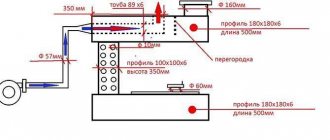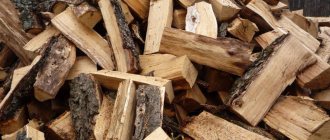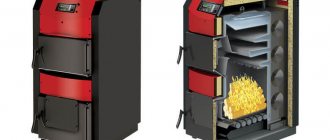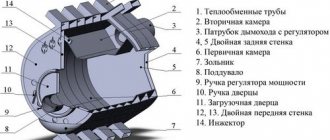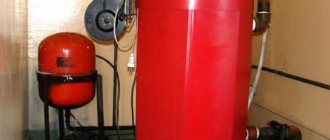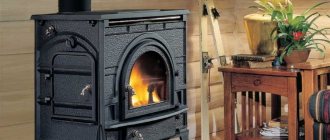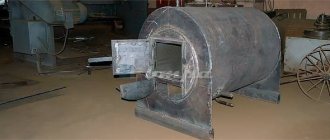An archaic fireplace looks beautiful, but the feasibility of its presence in a modern home raises doubts. I wouldn’t want to spoil the comfort of my home with soot. And the thought of a fire also worries me. It’s common to light a fire while relaxing in nature, but in your room it’s a little scary.
A safe solution would be a fireplace with a water heating circuit.
What is a fireplace with a water circuit
A fireplace is the oldest attribute of the interior of a human home. Since time immemorial, most family events have taken place around the hearth. Now you can buy a fireplace stove with a water heating circuit for the most sophisticated design.
Technological advances have led to a wide variety of designs for this traditional heat source. One of them is an aqua fireplace with the function of heating water circulating through the heating system. Now it can heat not just one room, but the entire house.
Principle of operation
A fireplace with a built-in water circuit works in the same way as a wood-burning stove for heating, which has a heating system heat exchanger built into its design.
Advantages
Installing a fireplace adds sophistication to the design. The room can be quickly warmed up when it gets cold outside or after a long absence from the country house. And the heating system of the entire building will start working immediately.
The benefits of purchasing an aqua fireplace do not end there:
- The fancifully shimmering flames are one of three paintings that you can look at endlessly. Relaxing by the fire is the most ancient, relaxing and soothing.
- The fireplace design does not contain moving mechanisms. There's simply nothing to break there. Durability is ensured by thousands of years of experience in using open fire.
- The aqua fireplace has a double body. Water from the house heating system circulates inside. The metal does not overheat from contact with an open flame, so the service life of the product is measured in decades.
- A traditional fireplace equipped with heat exchangers connected to the building's heating system has a coefficient of performance (COP) of 80%. This is the level of modern heat generators.
- A boiler can be connected to the aqua fireplace to provide the cottage with hot water supply.
- Fire safety is guaranteed by the use of a heat-resistant transparent firebox door. At the same time, the soft infrared spectrum of the flame freely penetrates through the glass, pleasantly warms the owners of the fireplace, and creates a cozy, warm atmosphere.
- Cheap fuel: firewood, coal, fuel briquettes - provides significant annual savings.
- Stove and fireplace heating is completely autonomous, which allows you to build a country house far from gas and electrical networks. The presence of a small-power electric generator makes it possible to use automated pellet feeding of the firebox for long-term continuous combustion.
- Modern aqua fireplaces are quite light. They can be installed without a foundation on a non-combustible base, for example, ceramic tiles.
- The varied designs of modern fireplaces have a common characteristic - compact sizes with a fairly high thermal output, which is important for small rooms.
- There is no inertia inherent in traditional massive furnaces. In a matter of minutes, a flaming flame will warm the room where the aqua fireplace is installed. If a circulation pump is provided, then the entire building is not afraid of sudden changes in outside air temperatures.
- The price of a massive stone fireplace or stove, together with the foundation and chimney, exceeds the cost of an aqua fireplace, the installation of which is quite simple, so it is possible to install it yourself. But it is now difficult to find a professional mason; his services are expensive.
- With a combined heating system, savings of up to 50% of the initial cost of gas equipment are possible. The maximum boiler power is calculated at the minimum winter temperature. At the latitude of Rostov-on-Don it is -24 °C. In practice, frosts rarely fall below -10 °C. When it gets colder, an aqua fireplace will help out. The rest of the time can be saved without sacrificing comfort.
Flaws
Modern people are spoiled by centralized heating of their homes, so even minor additional troubles with a fireplace can be very confusing.
However, there are not many problems:
- In strong winds, reverse draft is possible. Smoke and soot enter the room from the combustion chamber. To avoid such a nuisance, the chimney must rise above the ridge of the roof or be at a certain distance from it. The exact values for a specific case are calculated based on building codes and regulations (SNiP). Installing a deflector will help stabilize and increase traction.
- If a country house is not intended for permanent residence, then in winter the water from the heating system must be drained during absence. Otherwise the pipes will burst. The durability of the building and the safety of the interior will be guaranteed if the internal temperature is maintained at a level not lower than +10 °C. This can be achieved by automated pellet fuel supply or by installing an electric boiler for emergency heating.
- Installing a fireplace is more expensive than connecting an electric boiler. But electricity is one of the most expensive types of fuel. In addition, power outages are not uncommon.
- Regular cleaning of the chimney from soot is required 2 times a year, and more often with intensive use.
Source of thermal energy for the system
The part of the system that provides the transport function is not of interest to us. The theory of its functioning is needed in order to make heating with your own hands. As a source that would heat the water, you can use a gas boiler or an electric one.
Good to know: Which brick to use to make a fireplace, selection practice
The fireplace as a water heater turns into a multifunctional device. He continues his mission to provide the external decoration of the room and create comfort from the opportunity to contemplate the combustion process, but to warm up all the rooms, they use a fireplace with water heating.
The rather low efficiency index, especially for a fireplace with an open firebox, does not allow us to hope for high-quality heating during periods of severe frost. But for a small house this option is quite suitable. If you provide the ability to connect and disconnect the fireplace from the heating system, then the ideal option can be realized.
Commissioned furnace
The idea is that the main heating is taken over by the device that is intended for this purpose. At the right moment, the fireplace turns on and provides additional energy. At dachas, when the owners leave for a while, the fireplace can be turned off and the main boiler left running.
What does it consist of?
The design is extremely simple: body, firebox, heat exchanger. The housing can be free-standing. It is sometimes embedded in a solid wall or a decorative frame made of brick, forged or stone sculptures. The firebox is steel, but the grates are usually cast iron. Welded heat exchanger made of seamless pipes. An air duct is connected to the bottom of the firebox, and a chimney is connected to the top.
Frame
The metal casing of the aqua fireplace is hollow inside. Water circulates between the outer and inner walls. This is where its heating begins, and then it enters the upper register of the heat exchanger. As a result of this technical solution, the outer shell cannot even theoretically heat up above 100 °C, therefore it is completely fireproof.
A hob is sometimes placed on the upper plane. This design is relevant for small country houses, where the kitchen, dining room and living room are combined in one room.
The geometry of the case depends only on the designer’s imagination. The main thing is that the combustion chamber fits in it.
The combustion chamber
Conventional fireplaces had a low efficiency of 20% due to imperfect heat extraction during fuel combustion. The room was heated by the infrared radiation of the flame. There was a large portal in front so that the rays from the fire could warm the maximum area of the room.
Additionally, a small amount of heat warmed the air in the house due to convective heat transfer from the hot body. The remaining 80% of the heat escaped through the chimney along with combustion products - hot gases.
The design of aqua fireplaces provides for the possibility of changing the fuel burning rate by regulating the flow of supply air into the lower part of the firebox. The portal is closed with heat-resistant glass. It blocks uncontrolled access of air to the fire, which makes the aqua fireplace fireproof.
To reduce the likelihood of drafts, provide for the flow of air into the firebox through a pipe. A fine grill to keep rodents and cats away is installed outside. There is an adjustable damper in front of the fireplace.
On top of the portal there is a “clean glass” system - a longitudinal slot with guides for a small amount of fresh air from the room. A stream of cold air “flows” along the inside of the glass, preventing soot contamination.
Heat exchanger (water heating circuit)
In the upper part of the firebox there is a register of pipes for collecting heat from hot gases. The coolant, water, flows inside the pipes. If the power of the aqua fireplace is very high, then additional registers are placed along the side and rear walls of the firebox. To improve heat transfer and increase efficiency, there must be a circulation pump. As a result, the efficiency of the aqua fireplace increases to 80%.
When heated, water increases its volume, so it is necessary to install an expansion tank. With an open heating system, it is installed at the highest point - usually in the attic. When closed, the membrane-type tank is mounted in any place convenient for maintenance. A pressure gauge and a safety valve are mounted nearby.
Chimney
Ceramics or metal are used to remove gaseous combustion products. Ceramic chimneys are durable, but expensive and labor-intensive to install.
The smoke channel pipe is glazed during manufacture. This prevents soot from sticking and makes cleaning easier. It is separated from the chimney body by heat-resistant thermal insulation. At the bottom there is a container for collecting condensate.
Main characteristics of ceramic chimneys:
- service life - over 25 years;
- glassy surface prevents soot deposition;
- fireproof;
- do not burn out;
- a significant mass must rest on the foundation;
- high cost of components;
- complex installation.
Metal chimneys are much cheaper and easier to assemble. If the operating mode is violated, they may burn out.
Steel pipes are assembled using a sandwich design. The inner pipe made of technical stainless steel is separated from the outer one by fiber-basalt thermal insulation. Individual blocks are joined using heat-resistant sealant.
Characteristics of metal chimneys:
- the cost of purchase and installation is less than that of ceramics;
- it is possible to assemble it yourself;
- light weight, so no foundation is needed;
- Do not allow the flame to break through into the chimney.
How to build a water stove at home
- There are three ways to do stove heating with a water circuit with your own hands:
- buy a steel stove from a manufacturer whose services include system installation;
- hire a craftsman - a specialist will select the material, make the device, lay out the stove and install the boiler;
- do it yourself.
How to make such a stove yourself
The principle of a boiler for water heating
Can you make such a system yourself? Quite, just experience in welding and bricklaying when building a furnace is enough. First you need to prepare the boiler (register, coil, heat exchanger).
You can buy such a device or make it yourself using sheet iron and pipes. Since the full process of manufacturing and installing a water circuit cannot be summarized in a short review, the main recommendations are presented below.
Manufacturing options and recommendations
Water heating from a wood-burning stove - diagram
For the boiler, a sheet of metal with a thickness of at least 5 mm is used, and its design is made in such a way that there is maximum heating of the water for further circulation. The boiler, welded from sheet steel, is easy to manufacture and operate – it is easy to clean.
But such a heat exchanger has a smaller heating area, unlike a pipe register. It is difficult to make a pipe register at home yourself - you need an accurate calculation and suitable working conditions; usually such boilers are made to order by specialists who themselves install the system on site.
The simplest method of a solid fuel heat exchanger is a regular potbelly stove with a built-in water system. Here you can take a thick pipe as a basis, then there will be much less welding work.
Attention! All welding seams must be made double, since the temperature in the firebox is not lower than 1000 degrees. If you weld ordinary seams, there is a chance that this place will quickly burn out
Complete the register drawings in accordance with the dimensions of the stove at home. The layout of the rooms of the house and the arrangement of furniture also need to be taken into account.
Here you need to pay attention that it is better to choose a scheme with sheet-metal boilers - they do not have pipe bends connected into one continuous circuit. It is not so troublesome to build such a structure
It is also convenient because after installation you can use the hob without any problems, which is not the case with some tube boilers.
Register made of smooth pipes - drawing
When the coolant moves by gravity, you need to raise the expansion tank higher and use larger diameter pipes. If the pipes are of insufficient size, then you cannot do without a pump, since there will not be good circulation.
Boilers equipped with pumps have their pros and cons: you can save money by installing pipes of a smaller diameter and not raising the system so high, but there is one significant disadvantage - when the electricity is turned off or the circulation pump burns out, the heated boiler may simply explode.
It is better to assemble the structure at home, on site, since the device, like individual parts, has a very large weight and dimensions.
System installation
Heat exchanger made of cast iron battery
- Before installation, a solid foundation is poured, on top of which it is better to lay a layer of brick.
- The grate can be laid at different stages: before the boiler, if there is a double structure, the lower part of which can be equal to or higher than the upper part of the grate, when the stove is low and the system is placed a little higher, then the grate, doors, corner on the stove are usually installed after installing the boiler .
- The housing is installed - usually it consists of two containers connected to each other by pipes.
- The entire heat exchange system is welded to the boiler: the exhaust pipe goes to the expander, goes in a circle, through the radiators, and on the other side the return pipe is welded to the boiler from below.
Stove heating with a water circuit allows, firstly, to use firewood much more rationally, and secondly, to evenly distribute warm air throughout the heated room.
If you decide to make your own heating system at home with a water circuit using wood, think through all the stages of the work, and if you have doubts about the successful outcome, it is better to contact specialists.
Types of fireplaces
Wood-burning stove-fireplace
This modification arose as a result of a natural desire to replace a conventional wood-burning stove in a country house with an aesthetic fireplace. To do this, it was necessary to increase its efficiency.
The problem was solved by three design improvements:
- The air flow into the firebox is not through the open frontal plane, but through the grates from below. The intensity of fuel combustion is regulated by the position of the gate in the ash pit.
- The portal is closed with transparent heat-resistant glass. Infrared rays pass through it freely, heating the entire room.
- A heat exchanger is installed on top of the firebox.
Pellet fireplace
An alternative option was developed after the invention of pellets - granulated fuel from peat, organic waste from the woodworking industry, and agriculture. Standardization of the size of the new type of biofuel made it possible to automate the combustion process as much as possible.
The frequency of servicing the aqua fireplace has changed from several hours to a month. Ignition, control, and regulation of the process are carried out by a built-in controller.
The design of any pellet stove consists of several systems:
- Storage facility with gravity fuel supply system. As the granules are consumed, they fall down the inclined surface to which the vibration mechanism is connected.
- Fuel line with vacuum pump or screw doser.
- Built-in fireplace receiving hopper.
- Combustion chamber with flame control.
- Periodic cleaning of the chimney and ash chamber using spring mechanisms.
As the pellets burn out, fuel is supplied from the built-in hopper. The intensity of the supply of granules is automatically adjusted depending on the set room temperature and changes in weather conditions.
When the bunker is empty, the supply of biofuel is periodically switched on through a fuel line from the storage facility, the dimensions of which determine the duration of operation of the entire system without rebooting.
Operating principle
A stove with a fireplace and a water circuit is a chamber (steel, cast iron) with a wall thickness:
- 4 mm – open version;
- 6 mm – closed model.
The design diagram contains a heat exchanger in which several tens of liters of coolant circulates. Pipes extend from the heat exchanger, which drain water into the heating system and supply it to the radiators. To determine the temperature of the coolant, sensors may be provided in the design.
Fireplace stove with sensors and water heating circuit
As a rule, air access to the firebox is controlled manually. The device can be lined with various materials, so you can create an attractive fireplace in your home with your own hands. Sometimes the design includes a hob, which also allows you to prepare dishes.
Types of fireplaces by material of manufacture
To construct aqua fireplaces, brick, natural stone, ceramics, cast iron, steel sheet, basalt fiber insulation, and heat-resistant glass are used.
Brick
The fireplace stove can be custom-designed to almost any configuration. Finishing with tiles will emphasize the individuality of the interior. As a rule, high-quality working bricks (refractory) are used in such fireplaces.
Requires careful adherence to technology and high-quality installation. Installed on a separate foundation. The high starting cost is justified by the increased comfort.
Metal
The most profitable due to the optimal price/quality ratio. Light weight, affordable price, simple installation, and varied designs contribute to their widespread distribution.
Combined
They combine the comfort of infrared fireplace heating, the heat capacity of a massive stove, and the functionality of a water heating system. They have the highest possible efficiency. They release accumulated heat for a long time after the fire goes out.
A combustion chamber with a heat exchanger is built in during the construction of a brick or stone fireplace facade. Since access for repairs will be difficult later, the cast iron option is optimal. A separate foundation is required, so it is recommended to use a durable ceramic chimney.
Main advantages
This type of fireplace eliminates large heat losses through the chimney by connecting its firebox to a water heating system. Thanks to this feature, even distant rooms are heated, and the heat produced by it is retained in the house for up to ten hours. A fireplace with a water jacket has the most flattering reviews.
In addition to heat, such a heater has the function of heating water, and if installed correctly according to the connection diagram for additional heating equipment, it can heat up to 350 square meters. m of living space.
If an additional heating source is installed in the house, an automatic shutdown system is used, eliminating the irrational use of heat. According to this scheme, the heating device must be turned off while the fireplace is operating.
The function of turning off the heating in the summer allows you to use this device only for heating water, which makes it possible to significantly save energy.
Criterias of choice
When choosing, most buyers are guided by cost and their own taste, paying attention only to the appearance of the product.
It is also advisable to take into account other factors:
- thermal power;
- durability;
- burning duration of a disposable fuel filler.
Power is determined depending on the size of the house area and the minimum outdoor temperature in winter. The manufacturer indicates the corresponding characteristics in the product passport. If they are not there or the numbers are very approximate, then you can use the calculation method from SNiP.
Then you need to consider:
- climatic conditions in the place of residence;
- design characteristics of premises;
- size of heated area;
- number of external walls;
- orientation of the external walls according to the cardinal directions - south, east, west, north;
- thermal resistance of external walls, depending on the thickness and thermal conductivity of the material;
- outside air temperature during the coldest week of winter;
- ceiling height;
- what is below/above: a heated or cold room, an attic - insulated or not;
- degree of floor insulation;
- presence of a basement;
- number/size of windows;
- window design: wood or metal-plastic, double or triple glazing, argon filling;
- presence/size of doors to the street or balcony.
Each room must be counted separately. Then sum up the heat loss - this is the maximum power of the heat-generating unit, which will still need to be increased by a safety factor of 15-20%.
Choice
Note: First of all, you need to pay attention to an important parameter - power. The indicator is determined by the dimensions of the device (dimensions of the firebox). The ready-made options include documentation that will help you understand the technical qualities of the equipment in question.
When choosing, you need to focus on the rated power. The average figure is 1 kW of power per 10 m2 of house.
Brand matters. Since a fireplace stove is a dangerous device, it requires compliance with certain standards, which in most cases can only be provided by a trusted manufacturer.
Mass-produced long-burning fireplace stove
There are several offers on the market. For example, "Meta Group". The stoves are presented under the Aqua brand. They are manufactured using German technologies; foreign materials are used, which allows us to obtain reliable models. All products are adapted to difficult Russian operating conditions. The body is steel and coated with paint.
Ready-made branded stove-fireplace
The firebox is lined with fireclay bricks, so high temperature endurance is ensured and heat is retained. The range includes models that perform heating and cooking functions. As noted, they not only heat the house through pipes, but also allow you to cook food. These capabilities are realized through the use of one type of fuel and one device.
Serial fireplace stove
Foreign-made products are characterized by reliability, quality, and attractiveness. You can highlight the products of the Italian brand Edilkamin. The peculiarity of the models is that they can be combined with solar panels. Some devices have spits in their design, which also allow cooking food.
Fireplace stoves with water circuit MBS (Serbia)
Another manufacturer worth considering is Sky. The devices are characterized by large fireboxes, which guarantees increased efficiency. The finishing of the stove is made of stainless steel and glazed tiles. All models are equipped with additional options that simplify operation and improve application.
Demonstration of the stages of self-production of a fireplace stove with a water heating circuit
Popular models and their costs
Angara Aqua
Power 16 kW, dimensions 104 x 70 x 45 cm, weight 205 kg, cost from 32,000 rubles.
A characteristic feature is the convection grille in the upper part. Designed for accelerated heating of ambient air.
Prices for the Angara Aqua fireplace model
hangara aqua
Pechora Aqua
Power 18 kW, dimensions 104 x 75 x 49 cm, from 40,000 rubles.
The firebox is lined from the inside with a refractory lining. The prismatic side walls are decorated with ceramics. The convection niche is enlarged and can be used to heat food instead of a microwave.
Prices for the Pechora Aqua fireplace model
pechora aqua
MBS Thermo Vesta plus
Power 11 kW, dimensions 89 x 46 x 44 cm, 42,650 rub.
A diverse range of models is achieved by the capabilities of high-quality cast iron casting of component parts. The decent-sized upper platform allows you to boil a kettle or even prepare a simple dish. In this case, there is no heat exchanger.
Prices for the MBS Thermo Vesta plus fireplace model
MBS Thermo Vesta plus
EcoFireplace Alsace
Power 11 kW, made in Germany, dimensions 97 x 145 x 49 cm, RUB 189,900.
The external beauty and versatility of using tiles for external cladding are captivating. But it is completely unclear how the declared 80% efficiency is achieved. There are no water heat exchangers.
EcoFireplace Bavaria with stove and heat exchanger
Power 11 kW, dimensions 945 x 710 x 540 mm, RUB 47,200.
Increasing the volume of the firebox in width made it possible to obtain increased thermal power. This created enough space for the location of the cooking zones. A convenient option for small country houses with a combined kitchen-dining room. The prismatic glass facade heats almost the entire room.
MBS VULKAN
Power 17 kW, dimensions 85 x 48 x 60 cm, 66,440 rub.
A powerful, squat stove, solid and reliable.
La Nordica Termo Cucinotta
Power 9.1 kW, dimensions 68 x 86 x 65 cm, from RUB 178,400.
Italians are recognized trendsetters not only in clothing and shoes. Some fireplace models are worthy of installation in a royal palace. The advertised system of “tertiary combustion” of fuel may raise doubts among a professional boilermaker. At the same time, the declared efficiency of 78.8% is quite realistic in the presence of a water heat exchanger.
DIY making
Construction of a fireplace without relevant experience is possible if you have detailed drawings indicating the order of laying bricks. First, a concrete foundation is poured or it is laid out from blocks to the level of the subfloor. Waterproofing from roofing felt is installed on top.
It is advisable to use fireclay products for the firebox. The heat exchanger is preferably made of cast iron, but a welded pipe register with a wall thickness of at least 4 mm is suitable. The connections of the heat exchanger with the heating pipes must be located outside the firebox.
The rest is built from refractory bricks with clay mortar. After forming the vault, a chimney is mounted on top. It can be built without pipes from bricks at the back of the fireplace on its own foundation.
Before igniting after completion of construction, you must wait two weeks. Then fill the system with water. Carry out the first fire in a gentle mode, gradually increasing the flame.
Self-construction
Independent work without the involvement of specialists brings not only saving money, but also the indescribable pleasure of your own victory. Every craftsman will not miss the opportunity to install a water circuit for a fireplace with his own hands. To do this, all work must be divided into two parts: the construction of the building, the role of which is played by a brick fireplace, and the installation of a heat exchanger.
Construction of the building
The construction of any facility requires thorough preparation. First you need to find the necessary drawings showing the orderly laying of the fireplace. It is important to select only those materials that will allow you to build a fireplace with a water jacket in the form of separate channels. The walls of the jacket are framed with steel sheets for tightness.
Construction begins from the foundation. To do this, dig a pit, the area of which is slightly larger than the area of the future fireplace. To fill the foundation you will need the following material:
- crushed stone;
- sand;
- boards for formwork;
- cement;
- roofing felt
Initial stages of construction
The foundation level must be raised to the floor level. Before laying the fireplace, the surface is lined with sheets of roofing material for waterproofing. The fireplace body is lined with refractory bricks, and the firebox itself is lined with heat-resistant fireclay bricks. A clay mixture is used as a solution.
Preparing the solution is a long task. You will have to first test the clay for fat content, and then soak it to prepare a fine mixture of clay and sand. Today you can purchase already prepared and dosed mixtures, which just need to be diluted according to the instructions and they will be suitable for laying fireplaces. Due to the wide variety of mixtures, carefully read the instructions, which describe the scope of application.
The laying of the fireplace begins with horizontal rows that serve as the base. This is standard procedure for all models. At this stage, it is important to respect the horizon of the constructed foundation. Then the formation of the ash pan begins, as a mandatory part for all solid fuel fireplaces. The beginning of the construction of the firebox is also similar to most projects, but the finalization of this stage is distinctive. The fact is that you need to install the heat exchanger right now, otherwise there will be no such opportunity.
Good to know: How to build a brick fireplace with your own hands, we study the entire technology of the process
Heat exchanger
The simplest model of a heat exchanger is a small tank with two flanges to which pipes will be connected. One pipe will supply cold water, and the other will drain hot water. Flame has a destructive effect on metal. In addition to temperature differences, one should not forget about the chemical effect of combustion products. The material for the heat exchanger can be metal, about 4 mm thick. A smaller thickness will significantly reduce the life of the container.
Construction of a fireplace
More precise dimensions of the heat exchanger depend on the specific design of the fireplace. According to the established dimensions, the sheet of iron is cut. You must know how to use welding to construct the tank.
If you have enough experience in welding, then immediately think about increasing the efficiency of the device by making it from sections, registers, in the form of a labyrinth or a coil. The labyrinth is made from pieces of metal pipes and turning angles of the same diameter.
Self-installation
Modern lightweight models are standardized and therefore do not require much effort during installation. You will need a standard set of tools, minimal skills, and some free time.
Fireplace installation
Before installation, it is necessary to equip a non-combustible base made of steel sheet or ceramics.
Further according to the manufacturer's instructions:
- Install the fireplace level strictly vertically.
- Connect the heat exchanger to the heating system pipes.
- Mount the chimney and attach it to the firebox.
- Fill with water.
- Add half the fuel and light it up.
Connection to radiators
The aqua fireplace is compatible with both open and closed heating systems. For the main line, choose a pipe of at least 1.5 inches. It is mounted with a constant slope of at least 5 degrees. Radiators are connected with 1/2-3/4 inch taps.
Chimney installation and connection to the fireplace
The connection can be at the top or rear of the firebox.
The following rules must be observed:
- The diameter of the chimney must be equal to or larger than the outlet in the fireplace.
- A damper must be installed on the chimney.
- Horizontal sections cannot be more than 1 meter.
- The height of the chimney must correspond to the passport height.
- Intersections with ceilings and walls are insulated with non-combustible materials.
- There should be a revision on the chimney to remove soot, and at the bottom there should be a receiving bowl for condensate.
Making a connection
If necessary, such a fireplace can be installed in rooms of any size, both on the first or second floor, and in the basement.
Placement and connection:
- The water tank or hydraulic accumulator must be installed hidden; it is often placed in technical and basement rooms. This container must be equipped with an additional coil;
- Installation can be either open or closed. This applies to radiators (elements into which water already heated in the accumulator is supplied);
- Open systems are represented by an expansion tank, which is located at the top of the house. In this case, all excess water remains or is pumped back into the first container. This option is not very effective, and open systems are not capable of heating large and multi-story buildings and act as a source of additional heating, since during operation the water loses its specific gravity and the resistance of the pipes increases greatly. However, installation of such a system does not require the installation of additional sensors and elements, which makes it simple and inexpensive (the coolant is located in the coil);
- Closed systems are more efficient and powerful. In this case, the coolant has a membrane type and structure, thereby water enters its completely closed structure. Water can warm up to 100 degrees, after which it begins to move into the storage boiler (via a pump) and enters the water supply system of the house. To ensure that the water in such a system does not boil and fail, it is necessary to initially provide for the installation of an additional coil, into which cold water will be supplied in the event of a malfunction;
- The internal contents of the water circuit include special sensors capable of monitoring temperature conditions and, if necessary, performing an emergency shutdown.
Installation of fireplaces with a water circuit should be done by a professional
The simplest models are not equipped with a pump and additional temperature control sensors
Diagram indicating the direction of flows of cold and heated air masses in the external and internal parts of the structure
Uniform heating is achieved by connecting to the heating and water supply system of a private home
Some models can be lined with various fireproof materials and have different styles.
To visually familiarize yourself with the design features of such fireplaces and installation rules, we recommend watching the video in this article.
Recommendations for use and care
The use of fire in the house clearly implies increased attention to fire safety. In addition to the wood box, a bucket of sand and a fire extinguisher would also be useful next to the fireplace.
The maintenance method is practically no different from traditional methods:
- periodically monitor the water level or pressure;
- Clean the chimney of soot twice a year;
- remove ash regularly;
- wipe the fireplace glass with special liquids;
- Before the seasonal start-up, inspect the pipe connections;
- In winter, before leaving your country house, drain the water from all pipes.
The main stages of installing a fireplace with coolant
Layout of the stove-fireplace in the house.
The fireplace stove is made of refractory bricks. The first 2 rows of masonry, which are held together with oven clay, must be solid, then a small niche is laid out for the so-called ash pan (this is a box into which ash falls). The next row is the floor masonry, which is used for a special grate and its subsequent installation. On the front part of the stove it is necessary to leave space for the stove door, which is called a ash pan.
After laying the ash pan, you can proceed to laying the grate and firebox. Here, similarly, space is left for installing the door. The doors are secured between bricks to metal frames using metal wire. After finishing work on the firebox, pipes and a coil are sewn into the masonry. The upper ceiling of the fireplace is made of brick or a thick cast iron or steel plate. The chimney exits through the roof. During this work, fire safety measures must be observed: the metal pipe must be completely isolated from all ceilings that can ignite.
Water circuit system diagram.
The thickness of the walls of the heat exchanger in a fireplace with a water circuit must be at least 3-5 mm. If the wall thickness is less, then burnout is possible, which will lead to disassembly of the entire oven. The thickness of the wall also directly depends on the material that will be used: for coal the thickness should be greater, for firewood it should be less. In order for the stove boiler to heat up effectively and compensate for the effect of thermal expansion, there must be a gap of 1 cm between the heat exchanger and the wall of the firebox. If the heat exchanger is made of sheet steel, then the size of this gap will be only 1 mm. If the heat exchanger is made of metal pipes, then the gap is 1.5 centimeters. This gap allows the space to be cleaned.


